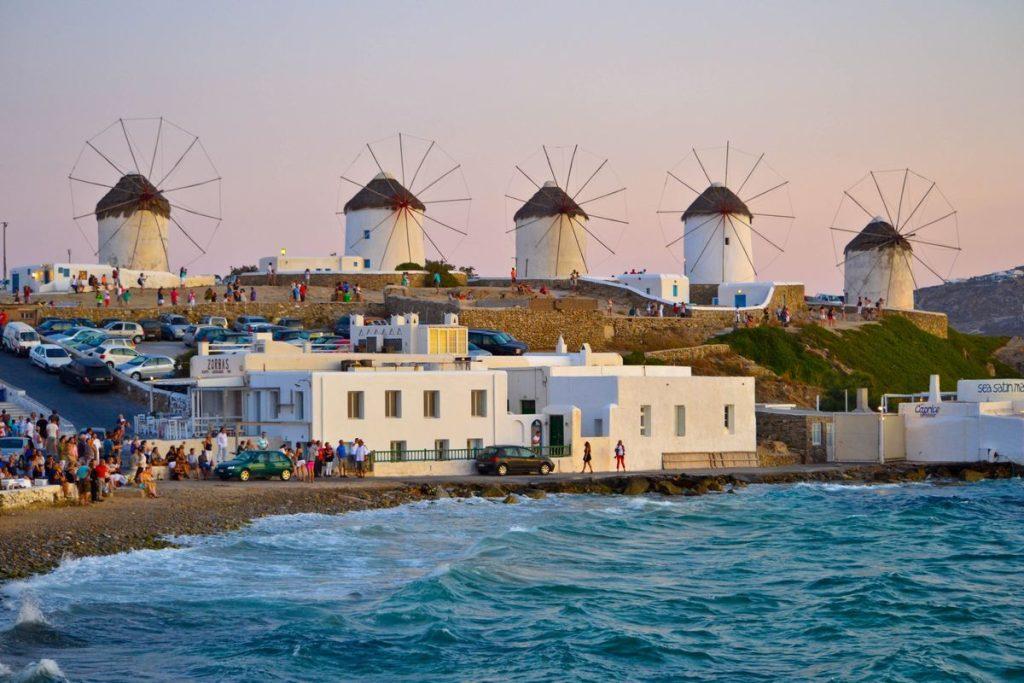
Visit the famous Mykonos windmills

The windmills are the trademark of Mykonos, an attraction whose fame has reached the ends of the world. There is no tourist who arrives in Mykonos and has not taken a photo at the white windmills to carry these memories back home. There is no sight that, combined with the blue sea, symbolizes the Greek summer and the beauty of Greece in the best way. Besides, over the years these wonderful Mykonos windmills have become «ambassadors» of our country abroad.
Today, bathed in the Aegean light, Mykonos windmills are the jewel of the island, but in the past they were an integral part of the island’s life, since strong winds blow there most of the year. The inhabitants of the island took advantage of the wind to grind their grain, in an effort to improve their living conditions, both in Mykonos and in the Cyclades in general.
«Lower Mills» and «Upper Mills»
Today most of Mykonos windmills, and the most well-preserved ones, are located south of Chora, between the picturesque Aleucandra and the district of Niochori and are known as «Lower Mills». They are white cylindrical buildings, facing the sea, with three floors inside, small windows and a cone-shaped roof.
In the past, this complex consisted of ten windmills, but today only seven of them are preserved. Some of these mills belonged to the municipality of the island and were used for grinding grain with the help of the northern winds that blow in the area. Nowadays they have been declared listed monuments and some of them have been renovated according to the specifications and used as residences.
Another complex of mills existed earlier in the east of Chora, known as «Upper Mills» and most of them were private. Today, a mill known as Boni’s Mill is well preserved and functions as an Agricultural Museum and is a branch of the Mykonos Folklore Museum.
The history of windmills
Windmills date back to the 15th century on the Greek islands, as residents used the wind to improve their daily lives. More specifically, in Mykonos it has been established that a total of 28 windmills operated until the middle of the 19th century. The windmills were mainly located in three parts of the island, but today very few of them are in good condition.
The strong winds combined with the fact that in the past, cereals were the main ingredient of the diet, turned Mykonos windmills into an important and necessary part of the island’s life. In fact, these windmills also helped the economic development of the island, as the inhabitants supplied the ships passing through their area with rusks.
In addition, even residents from neighbouring islands loaded their grain onto boats and transported it to Mykonos in order to grind it in the windmills, which were particularly popular due to the strong winds. It is also worth mentioning that in the past many of the mills belonged to wealthy families on the island or even to monasteries. This was because the construction of a mill was very expensive and difficult and only those with a good financial standing could support such a project.
Today they are monuments
Mykonos windmills began to lose their role and glory and become deserted around the beginning of the 20th century. With the development of technology the grinding of cereals stopped being done in traditional mills while trips to the sea took much less time and Mykonos ceased to be a stopover for supplies.
As a result most of the windmills of Mykonos became deserted. However, in the process they became one of the most famous and highly photographed sight of the island. Nowadays, some of the few windmills that were kept in good condition have been renovated and converted into residences.
It is estimated that about 2.000 windmills were built in the past on all the Aegean islands, which were a support for the local economies. One mill could grind from 20 to 70 kilos of grain in one hour, depending on the intensity and direction of the wind. The windmills were built in places where the north winds blew with greater intensity, relatively close to settlements, so that the movement of residents does not take too long and it was equally important that the place had no other buildings, so as not to «cut off» the wind.